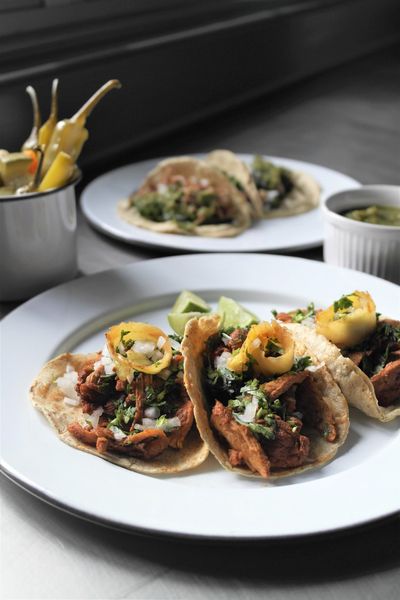Water Cooler: The history and how-to of tacos al pastor

Tacos al pastor is a signature Mexican street taco with a multicultural flavor palate.
The Spanish phrase “al pastor” roughly translates to “shepherd style” in English. This style refers to roasting pork on a vertical spit, which is a testament to its roots.
The iconic vertical spit houses a conelike stack of marinated pork, called shawarma, which originates from the Eastern hemisphere. In the late 1800s into the early to mid-1900s, an influx of Lebanese immigrants arrived in Mexico, bringing shawarma with them. By the 1930s, about 5% of Mexico’s population was Lebanese. Immigration continued as the 1948 Israel-Lebanon war and the 1967 Six-Day war followed.
The vast majority of Lebanese-Mexicans are Christian, which had one specific impact on their culinary influence in Mexico – they ate pork, unlike their Muslim and Jewish neighbors.
According to Jeffrey Pilcher, author of “Planet Taco: A Global History of Mexican Food,” tacos al pastor were first referred to as “tacos arabes,” or Arab tacos. They were served with more traditional options, such as flat bread rather than a corn tortilla and lamb instead of pork. The second generation of Lebanese Mexicans helped adapt the traditional shawarma techniques and combined them with Mexican cultural influences, such as switching to pork and seasoning it with a chili marinade.
Now tacos al pastor is a famous street food, with taqueros skillfully slicing the pork and chunks of pineapple off the vertical pit. The pit is so integral to the flavor of tacos al pastor, but it is somewhat impossible to recreate at home. Still, you can get pretty close with a few alternative methods.
In Mexico, the pork meat is usually from the leg. This isn’t as easy to find in the United States, so a boneless pork shoulder is a great alternative.
Make the marinade before preparing the pork. The classic ingredient for al pastor marinade is achiote. It has a mild, peppery flavor and a red brick color. It is dried and sold in a brick, but sometimes as a paste or powder. You can typically find it at a Mexican grocery store. It is often mixed with garlic, spices and herbs. As a cheat for the red chili adobo, you can use canned chipotle chiles in adobo.
To make the marinade combine the following in a blender:
One 100 gram package of dried achiote, broken into small pieces
3 peppers and the sauce from a 7-ounce can of chipotle chilis in adobo
2 cups water, or pineapple juice for extra sweetness and to cut the spice
¼ cup of neutral cooking oil
Blend until smooth.
Slice the pork shoulder into one-fourth of an inch thick slices. Marinate for one hour to overnight. If you want to do a slow roast that mimics the vertical pit, you can layer the slices over three metal skewers. If you would rather opt for a quick grill, pound the slices until they are one-eighth of an inch thick prior to marinating.
For a quick grill: Lay the pork slices on the grill and cook on high heat only on one side to create a textural contrast between the charred side and the soft side. Pull once it has cooked through after a few minutes.
For a slow roast: Set the grill for offset heating, with two-thirds of the grill on medium-high and one-third cold. Sear the stacked pork to get a light char on all sides, then place on the cold part of the grill. Roast for about 90 minutes to two hours at a temperature between 350 to 400 degrees .
Once cooked, slice thinly and serve on a corn tortilla, topped with chunks of grilled pineapple and sweet onion.
Pour over extra marinade or your preferred salsa and garnish with fresh cilantro leaves.